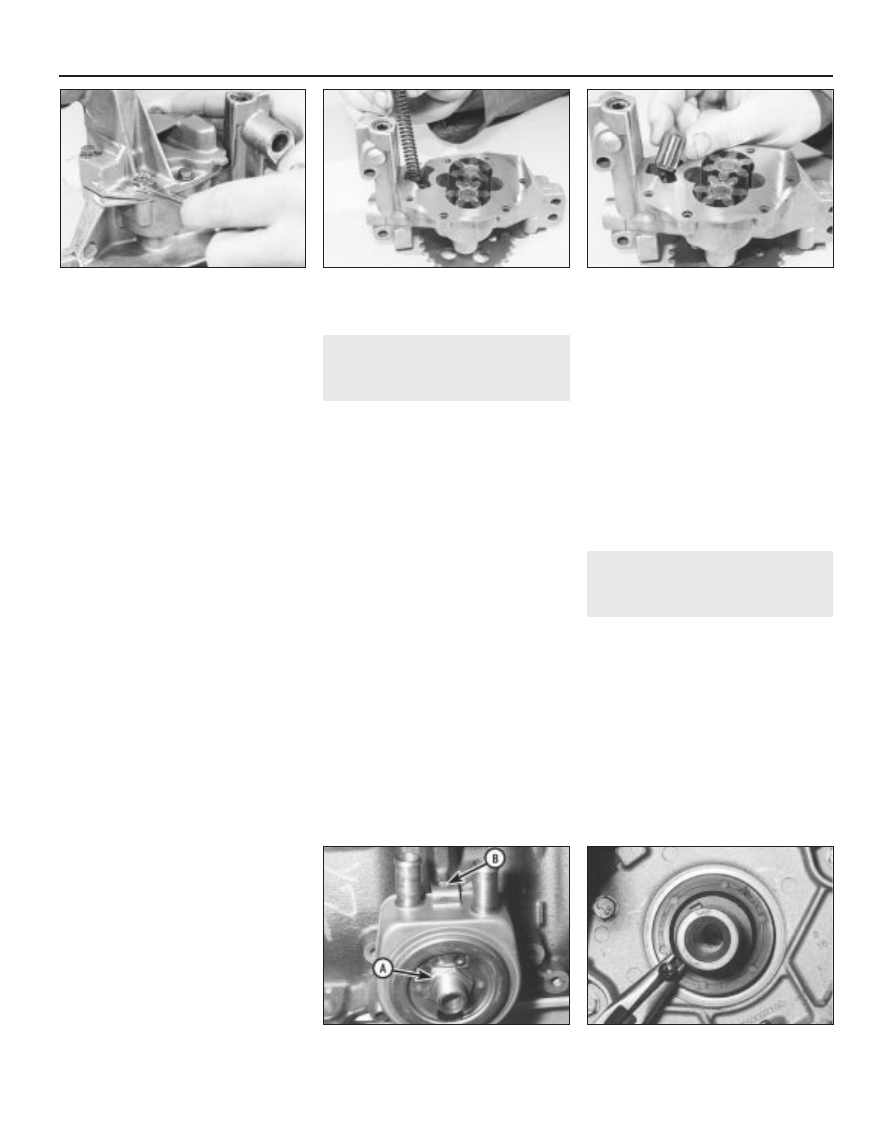содержание .. 18 19 20 21 ..
Peugeot 405. Manual - part 20

sprocket, fitted to the crankshaft, be renewed
at the same time. To renew the chain and
drive sprocket, first remove the crankshaft
timing belt sprocket as described in Section 8.
Unbolt the oil seal carrier from the cylinder
block. The sprocket and chain can then be
slid off the end of the crankshaft. Refer to Part
C for further information.
5 Slacken and remove the bolts (along with
the baffle plate, where fitted) securing the
strainer cover to the pump body. Lift off the
strainer cover, and take off the relief valve
piston and spring, noting which way round
they are fitted (see illustrations).
6 Examine the pump rotors and body for
signs of wear ridges or scoring. If worn, the
complete pump assembly must be renewed.
7 Examine the relief valve piston for signs of
wear or damage, and renew if necessary. The
condition of the relief valve spring can only be
measured by comparing it with a new one; if
there is any doubt about its condition, it
should also be renewed. Both the piston and
spring are available individually.
8 Thoroughly clean the oil pump strainer with
a suitable solvent, and check it for signs of
clogging or splitting. If the strainer is
damaged, the strainer and cover assembly
must be renewed.
9 Locate the relief valve spring and piston in
the strainer cover. Refit the cover to the pump
body, aligning the relief valve piston with its
bore in the pump. Refit the baffle plate (where
fitted) and the cover retaining bolts, and
tighten them securely.
Refitting
10 Offer up the spacer plate (where fitted),
then locate the pump sprocket with its drive
chain. Seat the pump on the base of the
cylinder block/crankcase. Refit the pump
retaining bolts, and tighten them to the
specified torque setting.
11 Where necessary, slide the sprocket
cover into position on the pump. Refit its
retaining bolts, tightening them securely.
12 Refit the sump as described in Section 13.
15 Oil cooler -
removal and refitting
2
Note: The oil cooler is not fitted to all models.
Removal
1 Firmly apply the handbrake, then jack up
the front of the vehicle and support it on axle
stands (see “Jacking and Vehicle Support”).
2 Drain the cooling system as described in
Chapter 1. Alternatively, clamp the oil cooler
coolant hoses directly above the cooler, and
be prepared for some coolant loss as the
hoses are disconnected.
3 Position a suitable container beneath the oil
filter. Unscrew the filter using an oil filter
removal tool if necessary, and drain the oil
into the container. If the oil filter is damaged or
distorted during removal, it must be renewed.
Given the low cost of a new oil filter relative to
the cost of repairing the damage which could
result if a re-used filter springs a leak, it is
probably a good idea to renew the filter in any
case.
4 Release the hose clips, and disconnect the
coolant hoses from the oil cooler.
5 Unscrew the oil cooler/oil filter mounting
bolt from the cylinder block, and withdraw the
cooler. Note the locating notch in the cooler
flange, which fits over the lug on the cylinder
block (see illustration). Discard the oil cooler
sealing ring; a new one must be used on
refitting.
Refitting
6 Fit a new sealing ring to the recess in the
rear of the cooler, then offer the cooler to the
cylinder block.
7 Ensure that the locating notch in the cooler
flange is correctly engaged with the lug on the
cylinder block, then refit the mounting bolt
and tighten it securely.
8 Fit the oil filter, then lower the vehicle to the
ground. Top-up the engine oil (refer to
“Weekly Checks”).
9 Refill or top-up the cooling system (as
applicable) -see Chapter 1. Start the engine,
and check the oil cooler for signs of leakage.
16 Crankshaft oil seals - renewal
4
Right-hand oil seal
1 Remove the crankshaft sprocket and
flanged spacer as described in Section 8.
Secure the timing belt clear of the working
area, so that it cannot be contaminated with
oil. Make a note of the correct fitted depth of
the seal in its housing.
2 Punch or drill two small holes opposite each
other in the seal. Screw a self-tapping screw
into each, and pull on the screws with pliers to
extract the seal (see illustration). The seal can
also be levered out. Use a flat-bladed
screwdriver, but take care not to damage the
crankshaft shoulder or seal housing.
2B•22 XU engine in-car repair procedures
14.5a Remove the oil pump cover
retaining bolts . . .
14.5c . . . and relief valve piston, noting
which way round it is fitted
16.2 Using a self-tapping screw and pliers
to remove the crankshaft oil seal
15.5 Oil cooler/oil filter mounting bolt (A)
and locating notch (B)
14.5b . . . then lift off the cover and
remove the spring . . .